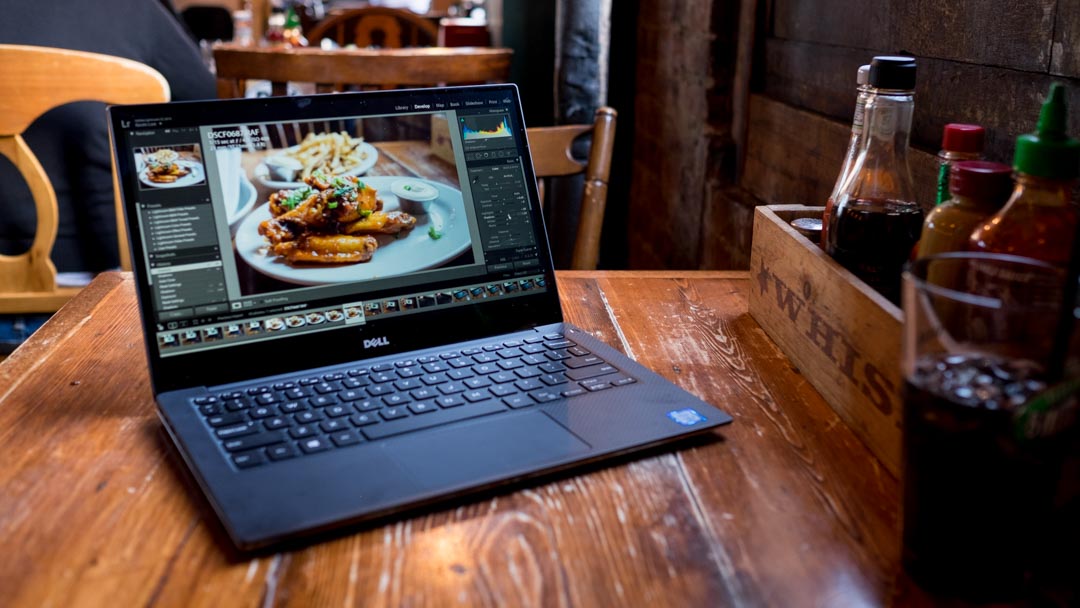TechRadar Verdict
Packing a high-resolution screen and serious processing power, there's more to the Dell XPS 13 than being a surprisingly small Ultrabook.
Pros
- +
Gorgeous bezel-less display
- +
Strong performance
- +
Lightweight
Cons
- -
No Ethernet port
- -
Off-center webcam
- -
Small frame limits battery life
Why you can trust TechRadar
[Editor's Note: Looking for the latest? Check out our take on the most recent Dell XPS 13 model for 2016 and 2017.]
If you're looking to purchase a powerful, portable and attractive laptop, the $799 (£849, AU$1,799) Dell XPS 13 is a top contender. The notebook features a sleek design, lightweight chassis and a revolutionary display that makes it the smallest 13-inch Ultrabook in its class.
In terms of size, this little boxer is actually closer to an 11-inch ultraportable, but it's a powerhouse outfitted with an Intel Core i7 Skylake processor and a fast PCIe solid-state drive (SSD).
The XPS 13 may have won the title of best laptop and Ultrabook last year, several worthy competitors have risen to challenge the claim. Lenovo has perfected its 2-in-1 laptop, the $1,199 (£1,449, AU$2,199) Lenovo Yoga 900, and equipped it with enough power to rival Dell's champion. Likewise, Apple has given the $999 (£849, AU$1,549) 13-inch MacBook Air a fresh set of internals and an even longer 12 hours of battery life.
Any of these laptops would make for an excellent buy. However, the XPS's innovative display and master class design differentiates it from what is an already-exceptional Ultrabook market.
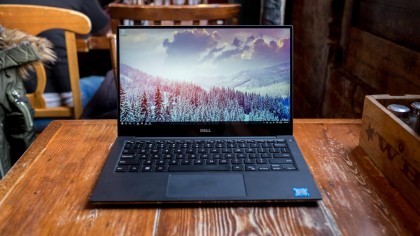
Design
The Dell XPS 13 truly is a revolutionary device, considering it packs a 13-inch screen into a much smaller frame. It looks deceptively small and, though it feels dense, the ultra-compact machine is light in the hand.
Both the top and bottom of the notebook are built from sheets of machined aluminum with a silver anodized finish, similar to the MacBook Air, in sheen and durability. After weeks of tossing the machine about in my travels, it still doesn't show any signs of wear, let alone fingerprints, smudges or scratches.
Sign up for breaking news, reviews, opinion, top tech deals, and more.

The palmrest and keyboard deck are made with an exquisite carbon fiber composite that's delightful to touch. The material's weave is visible, but Dell has coated the entire surface in a rubbery resin, mimicking the feel of soft touch paint. Unlike some other laptops with plastic or metal, the XPS 13's palm rest doesn't heat up over time and wicks away moisture. Even after eight hours of usage, I experience no discomfort or sweaty wrists.
Although the laptop is made up of two differing materials, the whole design coalesces neatly. The two durable, metal halves sandwich and protect the softer, carbon fiber interior engineered for maximum comfort. Beyond the overall excellent build of the XPS 13, Dell has included a few extra touches that elevate the quality of this machine.
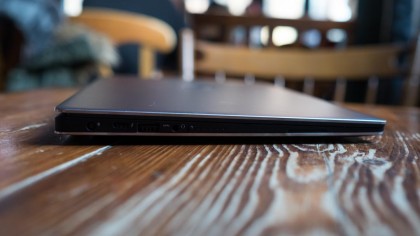
On the left hand side, there's a handy light-up battery gauge, something I haven't seen since the MacBook Pro did away with optical drives. When you press the button, you'll see a series of five small indicators light up denoting how much battery life is left (five notches being fully charged).
There's also an arguably useless – but still cool – metal flap on the notebook's underside hiding the serial number.
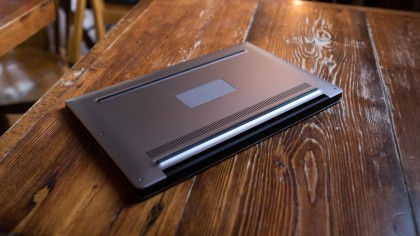
And despite the machine being so thin, there's a full set of ports including a SD card reader, two USB 3.0 ports and a newly added USB-C port that replaces the mini DisplayPort on the the previous XPS 13. The added ThunderBolt 3.0 support allows the connector to push a 4K signal, but you'll always need to plug in an adapter whenever you want to use an external display, as there are no dedicated video ports.
You'll also find the notebook's two side-firing speakers along the edges of the machine. While they don't produce bass-bumping audio, the sound quality is natural and fluid. This machine is nowhere as tinny and screechy on full-blast as other units we've tested – namely the Asus Zenbook UX305 – but this is by no means a device made for users that appreciate the full complexity of David Bowie's Life on Mars.
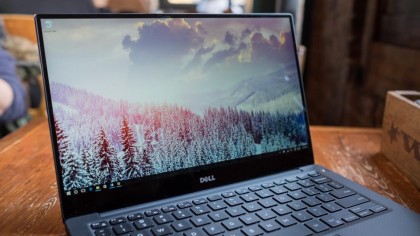
To 'Infinity' and beyond
Open up the lid, and you're greeted by a nearly bezel-less display, giving you 13.3 inches of screen real estate, while the laptop itself has a footprint of 11.9 inches. The screen-to-body ratio will also tickle your fancy, as the display covers 80% of the panel. Compared to the 13-inch MacBook Air, the XPS 13 has you looking at smaller black borders and 11% more screen real estate.
There's so little bezel, the LCD actually pushes all the way into the upper corners of the screen. Along the top and sides, there's barely any black lip and the biggest border measures about an inch on the bottom of the display. The extremely thin bezels provide a cinematic viewing experience, and it's easier to swipe in from the edge of the touchscreen.
The QHD+ version of the XPS 13 packs a 3,200 x 1,800 resolution display into a small laptop, most of which don't go beyond full HD resolution (1,920 x 1,080). The added pixels put the XPS 13 far above the 13-inch MacBook Air. It's also on par with other reigning 13-inch Ultrabook resolution champs: the Lenovo Yoga 900 and the Toshiba Satellite Radius 12.
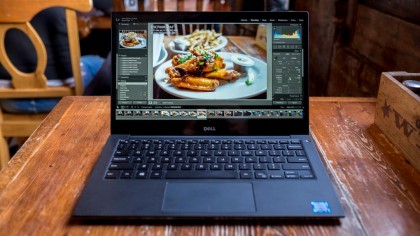
Though the display is plenty sharp, it's a bit on the cool side, causing whites to look slightly blue and a loss of shadow detail. It won't be too distracting for most users, but photographers and creative types will want to calibrate their screen for 100% accuracy before getting down to any serious media work.
One thing the XPS 13 isn't lacking is screen brightness. The 400-nit panel is blinding at full brightness and more than enough to overpower sunlight outdoors. While using it indoors, I find myself often sticking to settings below 25%, as it's more than radiant enough for an office environment.

Small fry
In order to make the XPS 13 as small as it is, Dell relocated the webcam to the lower left edge of the bezel. From this position, the camera captures your face from the chin up with a worm's-eye perspective. Not only is the angle unflattering, your nose hairs will be in full view of your virtual correspondents, and you'll terrify them with your massive hand if you try typing during the call.
Secondly, because the screen goes all the way to the top edges of the device, there isn't any room for your fingers to grab the top panel without pressing directly on the screen. The base of the laptop doesn't even include a little lip for you to slip your finger underneath. Instead, the whole device folds into one seamless block that's looks very clean but it's an absolute pain to open as your run your fingers along the perimeter of it, looking for someplace to pry it open.

Another consequence of the XPS 13's smaller frame is the keyboard is a smidge tighter than it would typically be on a 13-inch laptop. All the keys have been shaved a few millimeters on all sides, as has the spacing between each button. You also won't find a lot of travel on the keyboard, but the buttons respond with a satisfying springing action and audible click.
Luckily, the glass trackpad dodged any sort of cut backs. It's proportionally sized for the 13-inch screen, and the multi-touch gestures work perfectly to control Windows 10. In fact, if it were a bit bigger, this pointing device would easily be on the same level as the Microsoft Surface Book.
